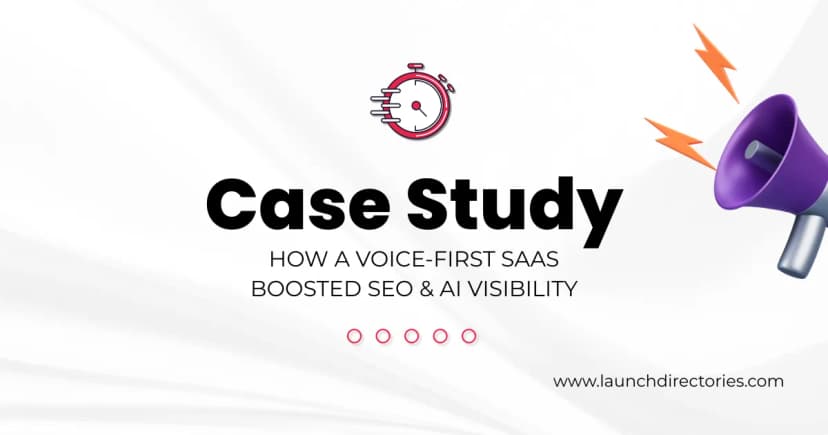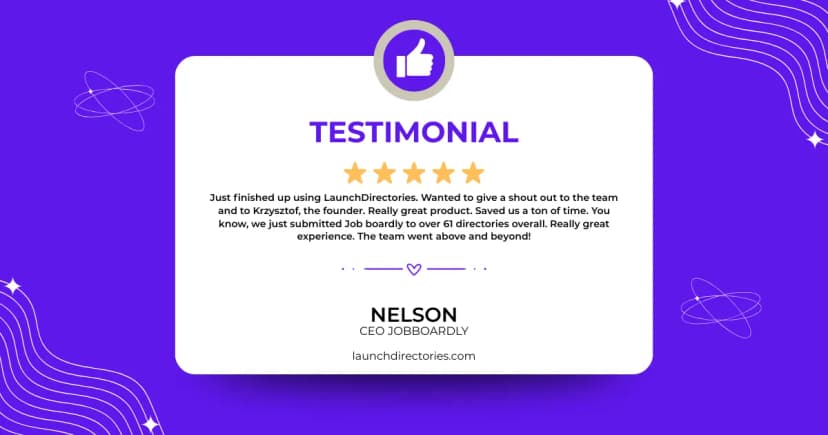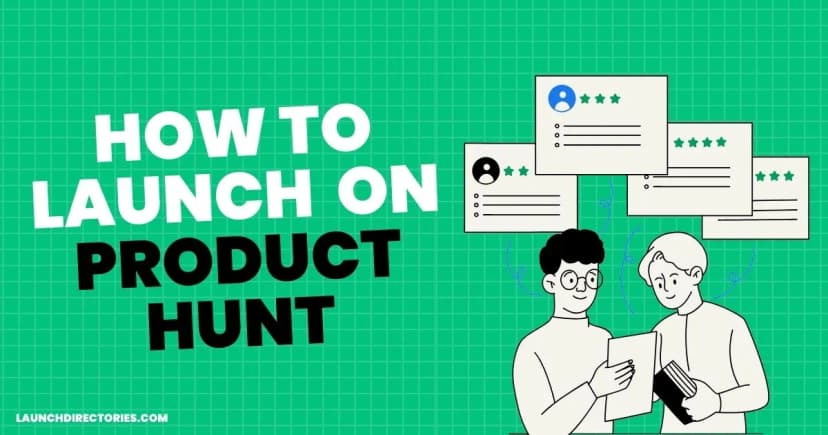
Why look beyond Product Hunt right now
If you are planning a launch, Product Hunt is a strong channel for awareness. It is not the only path to traction, feedback, or sustainable growth. In practice, most breakout launches combine a few proven channels: founder communities, review directories, investor hubs, and owned media that compounds over time. This guide breaks down product hunt alternatives through that lens. It shows where to post, how to craft submissions that actually get read, and how to convert short-lived spikes into steady signups.
You will find tactical advice, a comparison table, and an FAQ that answers common questions like where to launch besides Product Hunt, who lists new startups online, and how to get featured in app directories. Throughout the guide, we also highlight ways to save time with a consolidated directory workflow so you can launch once and get listed across many platforms. We will reference the phrase product hunt alternatives several times to match the search intent you used to find this guide, but the focus is practical steps you can execute today.
What this guide covers
Community-driven places that reward clear maker stories and quick iteration
Directory and review platforms that deliver steady discovery and SEO value
Founder and investor networks that open doors for partnerships and capital
Owned channels that keep working after launch day
A section-by-section set of key takeaways so you can move fast
Community platforms that convert early interest into traction
Community-first channels are often the smoothest product hunt alternatives because they are built around conversation, not just a leaderboard. The three that consistently deliver for early-stage founders are Hacker News, Reddit’s startup-focused spaces, and Indie Hackers.
Hacker News prioritizes substantive writeups. Makers who share a crisp problem statement, a live demo, and a few non-fluffy technical details tend to earn thoughtful feedback and qualified traffic. Be ready to iterate in public, answer questions in the comments, and follow up the same day. You can submit under Show HN, but only when your product is ready for honest critique. Visit Hacker News here: news.ycombinator.com. (Hacker News)
Reddit has many relevant communities, but r/startups, r/microsaas, r/SaaS are the best general entry point for launch feedback, customer discovery, and founder peer review. Before posting, read the rules, engage in existing threads, and prepare a short, clear title. Avoid heavy self-promotion. Share what you built, why you built it, and one specific question you want answered.
Peerlist is grounded in builder-to-builder transparency. Case studies and milestone posts that focus on your process rather than hype perform well. Share your revenue dashboard if you can, outline your acquisition channels, and ask for feedback on the next experiment you plan to run. Learn more about the platform’s Peerlisthere.
Twitter (X) works best when you treat it as an ongoing log, not a one-off launch announcement. Instead of dropping a polished “we’re live” post and disappearing, share small updates, screenshots, or quick threads about what you’re building and why. People engage more with behind-the-scenes stories than with marketing copy.
Community channels can feel slower than a single launch day, but they produce higher quality conversations and often lead to unexpected partners, early customers, or even hiring leads.
🔑 Key Takeaway
Pick one community to go deep on first. Share a crisp story, respond quickly, and turn the best comment threads into follow-up posts or a lightweight changelog that keeps people engaged.
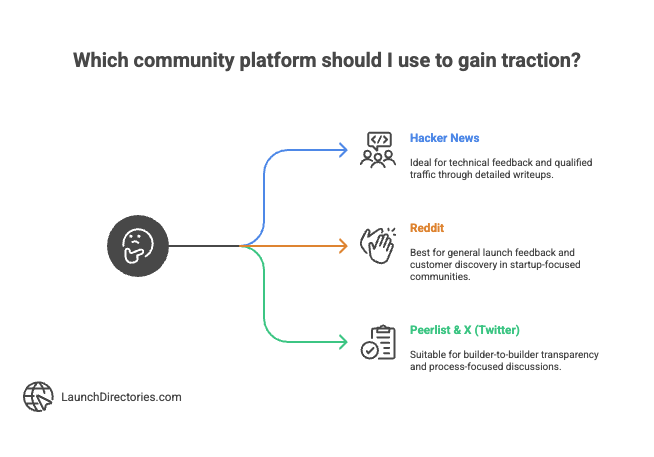
Directory and review sites that compound discovery and SEO
Short spikes are exciting. Sustained signups come from being findable when buyers actively search. That is where directory and review platforms shine. Two of the most useful product hunt alternatives for steady discovery are AlternativeTo and Capterra.
AlternativeTo is a crowdsourced catalog where buyers search for replacements to tools they already know. Your listing can rank on pages like “alternatives to X,” which captures intent from users already in solution-seeking mode. Optimize your page title for the problem you solve, select relevant tags, add platform coverage, and keep visuals sharp. See what AlternativeTo emphasizes on its about page: alternativeto.net/software/alternativeto/about
Capterra is one of the most recognized business software directories. It is driven by verified reviews, which means you should plan a review program before launch. Draft a simple outreach email for your first 20 customers, offer to jump on a short call if they have issues, and make it easy for them to leave an honest rating. Start here: capterra.com
with 100+ Directory Listings
Skip the grind. We'll submit your product to top directories so you get real users, feedback, and lifetime backlinks without lifting a finger.
These directories are not just for SEO. They influence buyer shortlists and give you language that resonates in your category. Read competitor profiles. Borrow the phrasing customers use, not vendor jargon.
Where directories fit in your launch stack
Add one or two high-visibility directories before launch week to start indexing
Layer community posts to drive fresh visits and early reviews
Expand to more niche directories after you have a stable onboarding flow
Revisit quarterly to refresh screenshots and messaging
🔑 Key Takeaway
Treat directory listings like landing pages. Use problem-first headlines, crisp screenshots, and a clear call to action. Plan a lightweight, ethical review workflow from day one. Check: How to launch successfully on platforms like Product Hunt.
Founder and investor networks that open doors
One reason Product Hunt became so popular is the promise of exposure to makers, investors, and early adopters. You can replicate the investor part with platforms designed for that job. AngelList is the canonical example.
AngelList has evolved into a broad platform for venture funds, syndicates, and startup-investor connections. For founders, it can help with visibility to angels and operators who already invest in your category. Create a profile that leads with traction and specificity. Include live metrics if possible, a crisp market wedge, and a one-sentence pitch anyone can repeat. Explore the platform here: angellist.com
A second value of these networks is credibility. Even if you are not fundraising today, a well maintained presence helps with recruiting and partnerships. Share product updates when they matter, and connect your public proof of work like docs, demos, or changelogs that show momentum.
When to prioritize investor platforms
You have repeatable user acquisition and clear unit economics
You need intros to angels with domain expertise
You are hiring for roles that respond to strong signals like traction and growth
If fundraising is off your roadmap, still consider these profiles as a form of reputation management. Many potential hires and partners will search your name and company there.
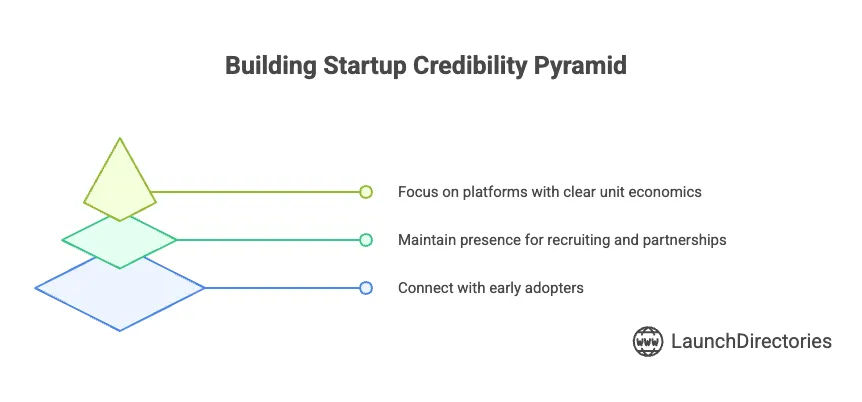
🔑 Key Takeaway
Use investor networks to signal seriousness. Lead with numbers, not adjectives. Keep profiles updated even when you are not raising so that future hiring and partnership conversations start stronger.
Owned channels that create durable advantages
Community posts and directory listings are rented space. Your website, email list, and content engine are assets you control. The fastest path to compounding results is to ship a simple content and email loop, refine onboarding, and use partnerships to expand distribution without paid ads.
Your website is the launchpad
Start by tightening the first fold. Lead with a simple problem statement, social proof, and a single call to action. Use one primary page for launch traffic to keep analytics clean. Add a short product video and an FAQ that answers what buyers ask on calls. If you have usage-based pricing or a free tier, show real numbers. Avoid vague benefits. Buyers compare pages quickly.
Email lists and waitlists
Email remains the highest leverage owned channel for early products. Run a short welcome sequence that sets expectations, ships one credible insight, and invites a reply. Those replies are a goldmine for roadmap and copy. Add a changelog that auto-posts to your list. Invite early users to opt into beta features. Tie product updates to pains you saw in the inbox.
Content that solves specific jobs
Build two to three cornerstone guides that solve real problems for your exact buyer. Use search-friendly titles, but write for humans. Reference your product only when it is the cleanest path to the outcome. Ship one walkthrough video per guide. Over time, these posts feed directories and community threads with something useful to link back to.
Partnerships and cross-promotion
If your product complements another tool, draft a mini partnership proposal. Offer an in-app integration tutorial, a joint webinar, or a shared case study. Partners often have email lists and communities that will outperform cold outreach. Trade value fairly and keep it small at first.
🔑 Key Takeaway
Balance rented attention with owned assets. Tighten your homepage, ship a simple welcome sequence, and publish one cornerstone guide per month. These are the engines that keep working after launch week.
Comparison table: channels to consider alongside Product Hunt
Use this as a quick filter. Pick one community, one review directory, and one network to start. Then expand with focus.
| Platform | Channel Type | Audience Strengths | Best For | Submission Cost | Typical Feedback Speed |
|---|---|---|---|---|---|
| Hacker News | Tech community forum | Engineers, product builders, researchers | Early feedback and technical critique | Free | Same day to 48 hours |
| Founder community | Broad founder base across industries | Qualitative feedback and customer discovery | Free | Same day to 72 hours | |
| Peerlist | Builder community | Bootstrappers and revenue-focused makers | Playbooks, accountability, milestone posts | Free | 1 to 7 days |
| AlternativeTo | App discovery directory | Solution seekers comparing alternatives | Ongoing discovery and SEO intent | Free | N/A - continuous |
| Capterra | Review directory | Software buyers with budget and timeline | Buyer shortlist influence and social proof | Free listing, paid options | 2 to 6 weeks for reviews |
| AngelList | Investor network | Angels, fund managers, operator-investors | Visibility for fundraising and recruiting | Free and paid options | N/A - network driven |
A practical launch sequence that blends these channels
Here is a lightweight plan you can run in two to three weeks.
Week 1 - Prep
Create a one-sheet with your product name, value prop, top 3 features, pricing, and a 120 word description
Record a tight 60 second demo
Draft three versions of your story: technical, business, and customer-first
Build a short welcome email sequence and an opt-in for early access or a discount for feedback
Write a milestone post for Indie Hackers and a Show HN draft that includes technical details, a link to a working demo, and what you want feedback on
Week 2 - Community and directory foundation
Post the milestone story on Indie Hackers and be available to answer questions the same day indiehackers.com/about
Submit your AlternativeTo listing with clean screenshots and tag coverage
Reach out to 15 design partners or early customers for initial Capterra reviews
Publish the demo and a lightweight changelog on your site so you can link to it from comment threads
Week 3 - Amplify and iterate
Submit a Show HN post only when you can answer hard questions and your onboarding is stable
Share a thoughtful progress thread on r/startups focused on lessons and one question you need help with reddit.com/r/startups
If fundraising soon, refresh your AngelList presence with traction, metrics you are comfortable sharing, and a clear ask angellist.com
This approach builds compounding assets while still capturing early attention. It also stacks social proof for later launches on other platforms.
How to craft submissions that get accepted and drive clicks
Write for the person skimming on a phone
Front-load the problem you solve
Avoid buzzwords and inflated claims
Use short paragraphs and bullets so readers can scan
Add two crisp screenshots that show the before and after
Show proof quickly
Include a live demo or a 60 second video
Share one small number that matters, like activation rate or weekly active users
Link to a public changelog so readers can follow progress
Ask one clear question
Examples: What is the biggest reason you would not try this today. Which onboarding step felt slow. What would make this a no-brainer for your use case.
Practice ethical review generation
Invite early users to leave an honest review only after they have completed a key action
Never gate features behind reviews
Thank reviewers publicly and fix what they point out
How to measure impact across channels
You do not need a complex analytics setup to learn. Use a basic stack and track a few ratios.
Unique visits by source and 7 day conversion to an activation event
Opt-in rate on your landing page
Share of signups that come from review pages
Reply rate on your welcome email
Time from first touch to paid upgrade
Use these simple metrics to decide what to double down on next month.
Where a curated directory workflow saves time
Manually finding and submitting to dozens of sites is slow. This is why curated directory databases exist. A single view of 80 plus launch platforms, with domain rating and link type, makes it easy to choose the high leverage places to list first. If you want to move faster, a done-for-you submission service can handle the repetitive parts across 100 plus directories while you focus on product and follow-up. Pair that with a founder-only community space so you can compare notes on what is working, avoid spammy channels, and keep your momentum steady.
FAQ: quick answers to common launch questions
What are the best product hunt alternatives for startups
Community-first channels plus one or two review directories work best. Start with news.ycombinator.com, reddit.com/r/startups, and indiehackers.com/about. Add alternativeto.net and Capterra.com for ongoing discovery. If you are fundraising soon, round it out with angellist.com. (Hacker News, Reddit, Indie Hackers, AlternativeTo, Capterra, AngelList)
Where can I launch my app besides Product Hunt
Pick one high-signal community and one directory to start. Communities give feedback and early users. Directories give you compounding search presence and reviews buyers trust.
Which communities have startup discovery platforms
Hacker News, r/startups, and Indie Hackers are the most reliable for maker-centric posts. Each has norms you should follow. Read the rules, be transparent, and focus on value rather than promotion. (Hacker News, Reddit, Indie Hackers)
Who helps founders promote new products online
Look for curated directory databases and manual submission services that specialize in startup launches. They help you prioritize by domain rating and link type, then handle the heavy lifting so you can keep building.
How do I get my startup featured in app directories
Craft a clear listing with an outcome-focused headline, clean screenshots, and a short video. Ask early customers for honest reviews. Keep your listing updated as you ship new features.
Best ways to showcase new tech products
Lead with a real user problem, show the demo fast, and publish a short technical post that explains how you solved a tricky part. Then direct readers to a quick-start guide on your site.
Who lists new startups online
Communities and directories handle discovery. Partners and creators handle amplification. A curated directory database can help you find the right sites faster so you spend less time researching and more time shipping.
Putting it all together
By now you have a clear map of product hunt alternatives and the sequences that work. Start with one community post where you can learn in public, add one or two directory listings that capture buyer intent, and maintain a credible presence on investor networks if fundraising is on your roadmap. Support that with an email list and a few cornerstone guides on your site. Review what worked after two weeks and double down on the channels that actually moved your activation rate.
If you want a shortcut, use a curated directory database to pick the highest leverage listings in minutes, or have a trusted team handle submission to 100 plus sites while you focus on product, onboarding, and follow-up. If you value peer learning and candid feedback, join a founder-only community that filters for real builders and blocks spam. The combination of these moves will help you turn a single launch day into a durable growth loop.
Ready to Build High-Quality Backlinks?
We'll submit your product to 100+ directories and build valuable backlinks for your SEO.
